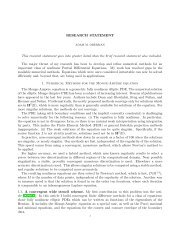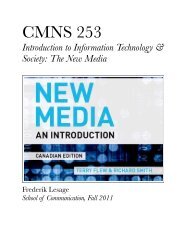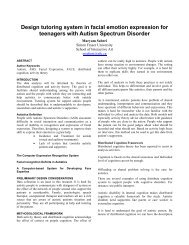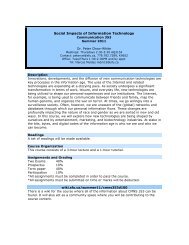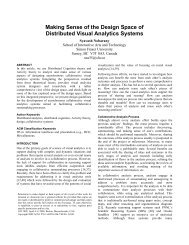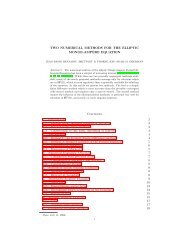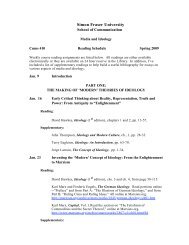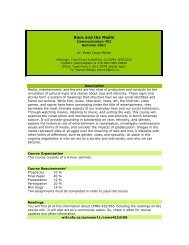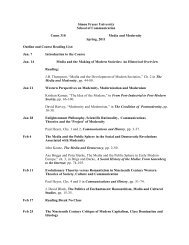SEX CHANGE CITY: - SFU Wiki
SEX CHANGE CITY: - SFU Wiki
SEX CHANGE CITY: - SFU Wiki
Create successful ePaper yourself
Turn your PDF publications into a flip-book with our unique Google optimized e-Paper software.
A History of medical services<br />
for transsexual people in british columbia, 1970 - 2007<br />
Rodney Hunt<br />
Keywords:<br />
British Columbia, British Columbia Health Insurance Services, British Columbia Medical<br />
Plan, British Columbia Medical Services Plan, MSP, Canadian Penitentiary Service,<br />
Centre for Sexuality Reproductive Health and Gender Issues, Christine Jorgenson,<br />
Committee on Human Sexuality, Erickson Educational Foundation, EEF, Gender<br />
Reassignment Surgery, Gender Clinic, Genital Reassignment Surgery, Genital<br />
Reconstrucive Surgery, GRS, Institute for Sexual Science, Magnus Hirschfeld, Medical<br />
System, Paul McHugh, Psychiatry, Psychoterapy, Sexualwissenschaft, Sex Reassignment<br />
Surgery, SRS, Transgender Health Program, Transsexual,<br />
Abstract:<br />
An overview of the history of sexual reassignment surgery, particularly as it relates to<br />
transsexuals in British Columbia.<br />
Time Period:<br />
1970-2006
Body:<br />
A History of medical services<br />
for transsexual people in british columbia, 1970 - 2007<br />
Introduction<br />
In this essay, I explore the history of medical services for transsexual people in British<br />
Columbia from 1970 to 2007. Drawing primarily on newspaper articles from the<br />
Vancouver Sun and The Province, I provide an historical overview of the local<br />
organization and development of medical services, with specific attention to provincial<br />
gatekeepers who were charged with the psychiatric evaluation of people wishing to<br />
change their sex and the provision (or non-provision) of provincial health funding for sex<br />
reassignment surgeries.<br />
The history of the organization of medical services in British Columbia is intimately tied<br />
to global changes in ideas about sex, gender, and sexuality that were, in part, shaped by a<br />
growing transgender movement of “ordinary and extraordinary human beings who<br />
searched for workable solutions to pressing personal problems” (Meyerowitz 2002:13). I<br />
begin this essay with a brief historical overview that situates the development of medical<br />
services in the context of early sexological work in Europe. However, my primary aim is<br />
to explore how local stories reported in the Vancouver Sun and The Province newspapers<br />
are tied to developments in North America that led to an increasing awareness of the need<br />
to provide transsexual people with access to medical care that met their needs.<br />
2
HISTORICAL CONTEXT<br />
Researchers have documented many stories of people throughout history whose gender<br />
was transgressive to established norms. Among these people, it is probable that some<br />
desired to change their sex (Devor 1999). The concept of transsexuality as we know it<br />
today – that is, as a medical category partly defined by the desire to change one’s sex – is<br />
relatively recent, however, making its first appearance in the medical literature in the<br />
middle of the twentieth century (Meyerowitz 2002:15). That said, the idea that one could<br />
change their sex existed for many years before the term “transsexual” was first used to<br />
label and categorized a distinct identity.<br />
Magnus Hirschfeld is widely considered to be a pioneer in the field of transsexualism and<br />
sex-change surgeries. In 1919, Hirschfeld founded the Institut füer Sexualwissenschaft<br />
(Institute for Sexual Science) in Berlin, which was the first clinic to regularly provide<br />
health services for transgender people (Meyerowitz 2002). Meyerowitz writes that “in<br />
the 1920s and into the early 1930s much of the sex-change experimentation centered in<br />
Berlin at Magnus Hirschfeld’s well-known “Institute for Sexual Science” (2002:18).<br />
Throughout the 1930s, the institute officially publicized its sex-change experiments.<br />
Early surgeries to change a person’s sex were typically incomplete, usually entailing the<br />
removal of a person’s breasts and/or parts of their genitals, such as testicles or uteri.<br />
According to Meyerowitz, “the first complete genital transformation arranged through<br />
Hirschfeld’s institute was a male-to-female reassignment for Dorchen Richter who was<br />
castrated in 1922 and in 1932 had her penis removed and a vagina surgically constructed”<br />
3
(Meyerowitz 2002:19). One of the first female-to-male sex reassignment surgeries took<br />
place sometime in the middle of the 1930s, when the Czechoslovakian Olympic runner,<br />
Zdenka Koubkova underwent surgery to become a man. Because she was an Olympic<br />
athlete, Koubkova’s story was widely publicized among accusations of men who<br />
masqueraded as women to gain advantages in Olympic competition (Cavanagh & Sykes<br />
2006).<br />
In contrast to a few isolated cases of early sex change surgeries in the United States –<br />
most of which were reported to have been conducted on intersexed patients – sex<br />
reassignment surgeries were a more widely acknowledged phenomenon in Europe than in<br />
North America. Although some North American doctors had the same surgical skills as<br />
doctors performing sex-change surgeries in Europe, few would provide their consent for<br />
transsexual people to change their sex. For the most part, medical intervention was not<br />
available in the United States until the formalization of a program to perform sex<br />
reassignment surgeries for transsexual patients was established at Johns Hopkins Hospital<br />
in Baltimore in 1966 (Meyerowitz 2002).<br />
Rapid advances made in the areas of plastic surgery and endocrinology throughout World<br />
War II made the possibly sex reassignment surgeries more widely known. In the years<br />
following the war, scattered media reports of transsexuality started to appear, and<br />
according to Meyerowitz, “a few popular magazines stated more clearly that doctors<br />
could change any person’s sex. With the dawn of the atomic age, magazines routinely<br />
expressed admiration for the power of science and the wizardry of technology”<br />
4
(2002:41). Throughout the late 1940s and early 1950s, transsexualism began to appear<br />
more and more on the pages of American newspapers. One of the culminating events in<br />
the history of medical services for transsexual people in North America occurred on<br />
December 1, 1952, when the New York Daily News reported the story of Christine<br />
Jorgensen’s return to the United States. Jorgenson was an American GI and male-tofemale<br />
transsexual who underwent sex-reassignment surgery in Denmark during that<br />
same year. Media reports of Jorgenson’s transformation caused a sensation around the<br />
world with the headline, “Ex-GI Becomes Blonde Beauty!”<br />
EARLY NEWSPAPER STORIES ABOUT SRS IN VANCOUVER<br />
The day following the New York Daily News report of Christine Jorgenson’s sex change<br />
surgery, both the Vancouver Sun and The Province newspapers published the story of<br />
Jorgenson’s transformation from an unhappy man to a “very natural and lovely woman”<br />
(Vancouver Sun, December 2, 1952). Though the stories were not front page news in<br />
Vancouver, the report was noticed and prompted at least one reporter from The Province<br />
newspaper to follow-up the next day with an exclusive report declaring, “Sex Switch<br />
Operation Once Performed Here” (December 3, 1952:29). Media coverage of Christine<br />
Jorgenson’s transformation brought the possibility of sex-change into the public’s<br />
imagination and the story motivated local newspaper reporters across North America to<br />
enquire about the possibility of local incidences of transsexualism and sex reassignment<br />
surgeries. For the December 3, 1952 edition of The Province, reporter Herc Monro<br />
interviewed a Vancouver doctor who claimed to have performed two early ‘sex switch”<br />
surgeries – one in Eastern Canada sometime during the early 1930s, and the second in<br />
5
Vancouver in 1940. Typical of early accounts of sex reassignment surgeries, the story<br />
reports the doctor as saying that these cases were to correct hermaphrodism. However,<br />
though not entirely clear in The Province article, the report states that “when changing<br />
sex, it is easier for the doctor to work towards the dominant characteristic” (29). Monro<br />
then goes on to write that the doctor found the Vancouver case to be “exceptionally<br />
difficult” because the patient, who was a male hermaphrodite with pronounced masculine<br />
characteristics, insisted on becoming a woman.<br />
By the end of the 1960s, the few North American doctors who were working in the field<br />
of transsexualism began to organize themselves into professional networks and<br />
associations. At the same time, small local support groups of transsexual people started<br />
emerging across Canada and the United States, advocating for their rights and pressing<br />
medical professionals for access to appropriate medical care (Meyerowitz 2002). The<br />
Gender Clinic at John Hopkins Hospital was opened in 1966, with partial funding from<br />
the Erickson Educational Foundation (EEF), an organization founded in 1964 by the<br />
philanthropist and transsexual man, Reed Erickson. The mandate of EEF was “to provide<br />
assistance and support in areas where human potential was limited by adverse physical,<br />
mental or social conditions, or where the scope of research was too new, controversial or<br />
imaginative to receive traditionally oriented support” (Devor 2005). According to Devor,<br />
in some way, the EEF supported almost every aspect of the educational and research<br />
support work that was done in the field of transsexualism in the United States during the<br />
1960s and 1970s (Devor 1999). With the opening of the Gender Clinic, Johns Hopkins<br />
6
ecame the first hospital to officially sanction support for sex reassignment surgery for<br />
transsexual people (Meyerowitz 2002).<br />
Meyerowitz points out however that the promise of the new clinic at Johns Hopkins<br />
Hospital was never fully realized in terms of the provision of sex reassignment surgeries.<br />
The numbers of transsexual people who were actually admitted to the hospital’s Gender<br />
Identity Clinic remained small; many of those seeking surgery were turned away<br />
(Meyerowitz 2002). In a foreshadowing of what was to become of the clinic at Johns<br />
Hopkins, a local story from the January 22, 1970 edition of the Vancouver Sun hinted at<br />
its failure to meet the needs of transsexual people. The story entitled, “B.C. Man Shifting<br />
Sex Hospital Won’t Say,” speculated that a 21-year old man from Surrey B.C. was one<br />
of 2000 people on a waiting list for sex reassignment surgery at Johns Hopkins (January<br />
22, 1970:66). According to the story, a spokesperson from the hospital would neither<br />
confirm nor deny the speculation, but added that the clinic had recently curtailed its<br />
program of sex-change surgeries in order to complete follow-up assessments of past<br />
patients that would inform a decision as to whether the program should continue. The<br />
story reported that the hospital had performed only 15 sex reassignment surgeries in the<br />
four years since the clinic opened in 1966.<br />
In 1975, Dr. Paul McHugh became the psychiatrist-in-chief at the Johns Hopkins<br />
Hospital. McHugh held strong beliefs that transsexualism was part of a large complex of<br />
personality disorders and he felt that those seeking to change their sex should be treated<br />
by psychiatrists rather surgeons. He later became notorious for insisting that sex<br />
7
eassignment surgeries were an unnecessary mutilation of the body, writing that the “zeal<br />
for this sex-change surgery – perhaps, with the exception of frontal lobotomy, the most<br />
radical therapy ever encouraged by twentieth century psychiatrists – did not derive from<br />
critical reasoning or thoughtful assessments (McHugh 1992). Shortly after his<br />
appointment as psychiatrist-in-chief, McHugh put in motion the steps that would<br />
eventually lead to the closure of the Johns Hopkins Gender Identity Clinic in 1979<br />
(Transsexual Roadmap).<br />
FIRST MOVES TOWARD MEDICAL SERVICES, 1970 - 1979<br />
Although few transsexual people had sex reassignment surgery at Johns Hopkins<br />
Hospital, the clinic did lead the way for the establishment of other gender programs<br />
across North America. According to Thomas MacKinnon, who wrote an article for the<br />
November 1972 edition of the B.C. Medical Journal entitled, “Sex Reassignment for the<br />
Transsexual in British Columbia” (1972:295), in the province during the early 1970s,<br />
programs for evaluating transsexual people for sex reassignment surgeries were<br />
underway at the forensic clinic at Vancouver General Hospital and the Health Sciences<br />
Psychiatric Unit at the University of British Columbia. However, because no sex<br />
reassignment surgeries were taking place in British Columbia at that time, a person<br />
granted approval for surgery would have to travel out-of-province for treatment. In the<br />
early 1970s, the closest gender identity clinics were the Seattle Counseling Center for<br />
Sexual Minorities at the University of Washington (which received referrals from British<br />
Columbia doctors) and at the Clarke Institute of Psychiatry in Toronto.<br />
8
The 1970s were at time of great change for transsexual people. As transsexual activists<br />
began to publicly articulate their needs, and legal challenges for recognition started to be<br />
addressed in the courts, professional attention and organization around transsexualism<br />
became increasingly formalized. Across North America, newly established gender<br />
identity clinics and university research units started to contribute new knowledge to the<br />
field of transsexualism. By 1972, the American Medical Association Committee on<br />
Human Sexuality had officially recognized sex reassignment surgeries as the preferable<br />
course of action for adult transsexuals, superseding the prevailing medical focus on<br />
psychotherapeutic treatment (Lothstein). Though the official recognition probably helped<br />
advance demands for the availability of appropriate medical care, which may have<br />
facilitated an increase in numbers of sex reassignment surgeries, the prevailing belief by<br />
medical professionals at the time remained that those who desired to change their sex<br />
lived with a psychopathology that would best be treated with psychiatric interventions.<br />
An example from Vancouver can be seen in a decision made by Vancouver Hospital in<br />
the early 1970s. According to MacKinnon (1972), sometime prior to 1972, the Medical<br />
Board at Vancouver Hospital considered a report of a committee that had been appointed<br />
to look into the possibility of opening a Gender Identity Clinic. After meeting to discuss<br />
the issue, however, the Board decided not to proceed with such a program because of the<br />
possibility of “unfavourable publicity” against the hospital. According to MacKinnon,<br />
the decision of the Medical Board was at least partly based on their belief that providing<br />
an opportunity for a person to change their sex might do more psychological harm than<br />
good, risking the creation of more “problems in the mind of the patient” (1972: 296).<br />
9
During the early 1970s, the British Columbia Health Insurance Services (known as the<br />
B.C. Medical Plan), was also opposed to the idea of providing sex reassignment surgeries<br />
in the province (MacKinnon 1972). The B.C. Medical Plan apparently rejected the idea<br />
based on administrative reasoning, stating that the decision was made as part of a<br />
provincial-wide effort to cut down on the incidence of surgery generally. That said, in<br />
1972, some funding did exist for specific out-of-province sex reassignment surgeries,<br />
which may have benefited at least a few adult transsexual patients. In a Vancouver Sun<br />
article from May 4, 1972, Ann Barling reported that B.C. Medical Plan funding “for<br />
conversion surgery outside B.C. is granted only when information clearly indicates the<br />
proposed surgery is medically required in order to correct a biological or congenital<br />
anomaly” (Barling 1972).<br />
In the same Vancouver Sun article (1972), Barling reported that in the two years since<br />
1970, the Health Sciences Psychiatric Unit at the University of British Columbia had<br />
evaluated up to 30 people for sex reassignment surgeries. In addition, from an interview<br />
with a therapist at the UBC Health Sciences Psychiatric Unit, Barling notes that there<br />
were an estimated 150 and 200 transsexual people seeking medical services in Vancouver<br />
in the early 1970s. By 1972, the Seattle Counseling Center for Sexual Minorities had<br />
apparently received dozens of inquiries about sex reassignment surgeries from people in<br />
almost every province in Canada (Barling 1972). By the same year, two transsexual<br />
people from British Columbia had completed their surgeries in Seattle, and<br />
approximately ten applicants from the province had been interviewed by clinicians at the<br />
Seattle Centre and were awaiting treatment (MacKinnon 1972).<br />
10
Lack of funding by the provincial government, however, made it difficult for most<br />
transsexual people who had been approved for sex reassignment surgeries to receive the<br />
treatment they sought. In the early 1970s, in order for an application to be considered by<br />
the Seattle Center, for example, an applicant for surgery had to agree to a number of<br />
requirements including participation in a long-term follow study, which necessitated a<br />
security deposit of $1500 as insurance against non-compliance (MacKinnon 1972).<br />
Though the Seattle Centre was a research center that operated with funds from research<br />
grants, and did not charge patients for surgeries, applicants for sex reassignment surgery<br />
were also required to prove they had at least $1500 in the bank to cover the cost of any<br />
post-operative complications that might occur (Barling 1972). Moreover, MacKinnon<br />
notes that even if provincial funding was available for out-of-province surgeries, in the<br />
early 1970s, the Seattle Center had no authority to accept B.C. Medical Plan payment for<br />
costs incurred.<br />
Canadian Penitentiary Services<br />
An interesting story from the January 31, 1976 edition of the Vancouver Sun, with the<br />
title, “B.C. Pen inmate undergoes operation to change his sex” (13), reported that a 24-<br />
year old male-to-female transsexual had recently undergone a “mainly cosmetic<br />
operation” at Royal Columbian Hospital in New Westminster as a follow-up to surgery<br />
received prior to incarceration in Vancouver and San Francisco. According to the story,<br />
the surgery was performed in accordance with Canadian Penitentiary Service guidelines<br />
that specified the provision of medical services be granted to inmates in order attain and<br />
maintain their physical and mental well-being. Though the story might otherwise be<br />
11
unexceptional, it is worthy of note because of the provincial context in which gender<br />
identity evaluations and sex reassignment surgeries were taking place at that time. In<br />
addition, throughout the 1960s and into the 1970s federal prisoners in the penitentiary<br />
system could volunteer as test subjects for various experiments. According to an article<br />
published in the Ottawa Citizen newspaper on September 28, 1998, during the 1960s and<br />
early 1970s, Canadian Penitentiary Service inmates “took part in trials of the<br />
hallucinogenic drug LSD, other unproven pharmaceuticals, and food additives, as well as<br />
in sensory deprivation research and pain studies. Drug companies were welcomed into<br />
various prisons to conduct trials, but some of the research was funded or sponsored by<br />
federal agencies, including the Health Department and the Solicitor General. Given that<br />
there was no officially organized team of surgeons performing sex reassignment surgeries<br />
in British Columbia at that time, it is possible that the surgery was conducted as part of an<br />
experiment in plastic surgery.<br />
THE CENTRALIZATION OF MEDICAL SERVICES, 1980 – 2000<br />
<br />
In the spring of 1982, the B.C. Medical Services Plan begins to fully or<br />
substantially cover out-of-province SRS in accordance with the Federal Health<br />
Act (up to the rate that would have been paid had SRS been available in BC).<br />
<br />
Prior to 1984, clinical evaluations for transsexual people seeking out-of-province<br />
SRS were handled by a handful of clinicians in private practice, as well as through<br />
an unstructured arrangement between Dr. Diane Watson of South Burnaby Mental<br />
12
Heath, Dr. Jerrilynn Prior of UBC School of Medicine, and Ms. Pat Diewold,<br />
Clinical Psychologist at VGH.<br />
<br />
During this time, the majority of transsexual people travelled to either The Clarke<br />
Institute in Toronto or to London England for SRS.<br />
<br />
In 1984 the Centre for Sexuality, Reproductive Health and Gender Issues (The<br />
Gender Clinic) at Vancouver General Hospital was established by Dr. Diane<br />
Watson to focus on the assessment and treatment of transsexual people.<br />
<br />
In June 1988, the Social Credit government of Bill Van der Zalm blocks SRS<br />
funding and the B.C. Medical Services Plan de-lists coverage. Funding is no<br />
longer available.<br />
<br />
In the fall of 1993, Stephanie Castle travelled to Victoria to meet with a person in<br />
the Ministry of Health who was undertaking an internal review on transsexualism.<br />
At this meeting, Stephanie discovers that, apart from the first year of delisting<br />
SRS from MSP coverage, SRS funding had in fact been available in BC from late<br />
1989. Access to the funding, however, was not made available to anyone except<br />
those inside the Ministry. Even clinicians at the Gender Clinic were not aware<br />
that they could apply for funding on behalf of their patients.<br />
13
In 1994, controversy arises when it is reported that the Ministry of Social Services<br />
had fully paid for the cost of SRS for two transsexual people receiving welfare<br />
benefits.<br />
<br />
In June 1995, the exclusion of SRS from MSP was officially repealed by the then<br />
NDP government of Mike Harcourt, and “full” funding is reinstated for SRS.<br />
<br />
In March 1997, a contract was entered into between the B.C. Ministry of Health<br />
and Dr. Toby Meltzer in Portland Oregon for paid for out-of-province SRS.<br />
THE TRANSGENDER HEALTH PROGRAM, 2000 - 2008<br />
<br />
In May of 2002, the Gender Clinic closes as a result of budget constraints<br />
imposed by the BC Liberal government of Gordon Campbell. Vancouver General<br />
Hospital makes cuts throughout the Department of Psychiatry, including several<br />
staff positions at the Gender Clinic. The remaining staff could not continue to<br />
provide adequate services and announced the closure of the program.<br />
<br />
In 2002, Vancouver Coastal Health Authority supports a community consultation<br />
and survey of transsexual people in B.C. on transition and cross-dressing services<br />
in British Columbia. The Director of Mental health Services at VCHA<br />
commissions a report outlining recommendations for a Transgender Health<br />
Program to provide support, information, referrals, and advocacy.<br />
14
In June 2003, the Transgender Health Program at VCHA is launched from Three<br />
Bridges Community Health Centre.<br />
<br />
In 2008, under the auspices of the Transgender Health Program, a new Sex<br />
Reassignment Surgery (SRS) Program is created in Vancouver with the aim of<br />
offering all SRS procedures within British Columbia. Plastic Surgeon, Cameron<br />
Bowman is coordinating the development of an interdisciplinary team of<br />
specialists (very recent changes to be investigated).<br />
<br />
According to the April 2008 B.C. Medical Association Guide to Fees, “Gender<br />
Reassignment Surgery” is deemed a benefit of MSP, but only following prior<br />
approval. Approvals require that patients are assessed by two psychiatrists.<br />
Individual assessments are then considered by the Gender Reassessment Review<br />
Committee before being recommended for SRS.<br />
15
REFERENCES<br />
Barling, A. (1972). Transsexuals drawn to Vancouver. The Vancouver Sun. May 4,<br />
1972.<br />
Blanchfield, M., and Bronskill, J. (1998). An extreme case of questionable ethics:<br />
Debate on the morality of the tests in prisons unfolded in the shadows. The<br />
Ottawa Citizen, September 28, 1998. Retreived online April 23, 2008 from http://<br />
www.aches-mc.org/ethics2.html<br />
Castle, S. (2005). The Zenith Experience: Encounters and Memories in a Transgender<br />
Setting. Vancouver, BC: perceptions Press.<br />
Cavanagh, S.L. & Sykes, H. (2006). Transsexual Bodies at the Olympic: The<br />
International Olympic Committee’s policy on Transsexual Athletes at the 2004<br />
Athens Summer Games. Body & Society, 12(3), 75-102.<br />
Devor, H. (1997). FTM: Female-to-Male Transsexuals in Society. Bloomington, IN:<br />
Indiana University Press.<br />
Devor, A. H. (2005). Reed Erickson and The Erickson Educational Foundation.<br />
Retrieved online April 19, 2008 from http://web.uvic.ca/~erick123<br />
Farrow, M. (1987). B.C. pays sex-change expenses. The Vancouver Sun. Vancouver,<br />
B.C.: August 12, 1987. p. A7.<br />
Goldberg, J. (2004). First Year Report: Transgender Health Program. Report prepared<br />
for Vancouver Coastal Health, July 7, 2004.<br />
Goldberg, J. (2003). Transition and Crossdressing Service Delivery: A Review. Report<br />
prepared for Vancouver Coastal Health Authority, February 21, 2003.<br />
Kopala, L. (2003). Recommendations for a Transgender Health Program. Report<br />
prepared for Vancouver Coastal Health Authority, April 26, 2003.<br />
Lothstein, L.M. (undated). Sex Reassignment Surgery: Historical, Bioethical, and<br />
Theoretical Issues. Retrieved online April 20, 2008 from<br />
http://www.jadephoenix.org/lvtgw/Info_htm/Sergical/reassurg.htm<br />
MacKinnon, T.J. (1972). Sex Reassignment for the Transsexual in British Columbia.<br />
B.C. Medical Journal, 14(11), p.295.<br />
Mason, G. (1987). Dueck balks at sex-change funding. The Vancouver Sun. August 13,<br />
1987.<br />
McHugh, P. (1992). Psychiatric Misadventures. The American Scholar, 61(4), 497-510.<br />
16
Meyerowitz, J. (2002). How Sex Changed: A History of Transsexuality in the United<br />
States. Cambridge, MA: Harvard University Press.<br />
Munro, H. (1952). City Doctor Did Work Without Hormones: Sex Switch Operation<br />
Once Performed Here. The Province, December 3, 1952. p.29.<br />
Padmore, T. (1980). Frankie yearns to be a normal woman. The Vancouver Sun. April<br />
22, 1980.<br />
Transsexual Roadmap (undated). Paul McHugh on transsexualism. Retrieved April 23,<br />
2008 from http://www.tsroadmap.com/info/paul-mchugh.html<br />
Vancouver Sun. (1977). Trans-sexuals ‘in limbo’ unless law is changed. February 15,<br />
1977.<br />
Vancouver Sun (1976). B.C. Pen inmate undergoes operation to change his sex. January<br />
31, 1976. p.13.<br />
Vancouver Sun. (1970). B.C. Man Shifting Sex Hospital Won’t Say. January 22, 1970.<br />
p.66.<br />
Vancouver Sun. (1952). Ordeal Turns Man Into Lovely Girl. December 2, 1952. p.7<br />
Watson, P. (1982). Transsexuals a rough crossing. The Vancouver Sun. August 17,<br />
1983.<br />
17




